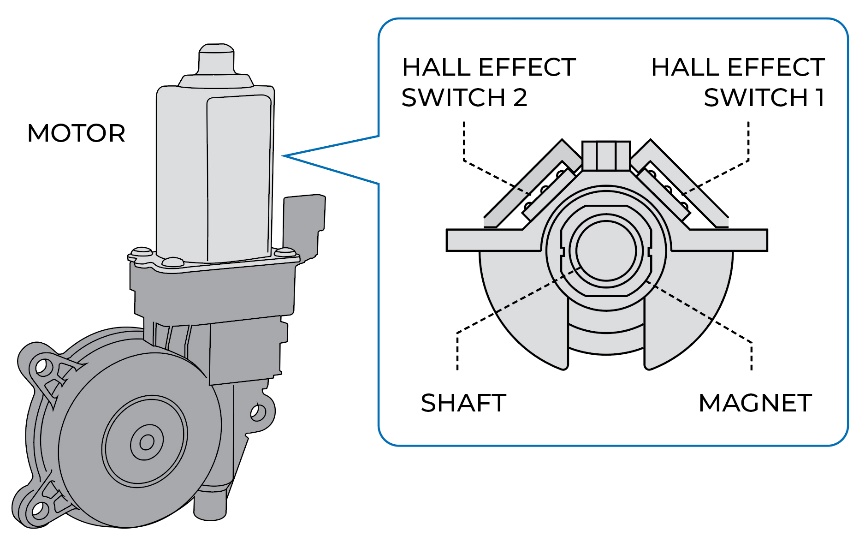
With the growth of electric vehicles, the demand for small, precise position sensors in automotive applications will grow significantly to $1.6 billion by 2026 (Figure 1). These sensors track the position of the rotors in the motors responsible for the traction machinery, power steering and Windows, and ensure control and safety coverage. First, this paper reviews the traditional approach and position detection methods and their limitations. Next, before discussing the limitations of use in automotive applications, consider the operation and advantages of magnetic proximity sensors and position sensors based on the Hall effect. Finally, this article describes a series of Hall sensor switchers/latching circuits that enable automotive systems to achieve the highest level of automotive safety certification: ISO 26262.

Figure 1. The electrification of vehicles is driving the demand for position and proximity sensors
Problem of traditional position sensing technology
Potentiometers, optical encoders, and Angle untanglers are the most widely used for position sensing, but each has disadvantages that affect their use in automotive applications.
Potentiometers use solid contact to measure rotational action. However, this means that they are subject to mechanical wear caused by friction, and their performance may be affected by shock or vibration. In addition, contamination of resistance components with foreign objects such as dirt, dust, moisture or grease can impair performance and even lead to premature failure.
The optical encoder measures position by detecting the alternating light and dark regions created by the rotation of a disc with an opening (often called a code disc) between an LED light source and a photodiode sensor. However, they are easily contaminated, which can interfere with light sources and detectors, reducing reliability. Another disadvantage of optical encoders is that they are bulky (a problem in space-constrained cars) and must be precisely assembled to reduce tolerances to extremely low levels.
The Resolver uses an electromagnetic converter to measure the position at high speeds. While they are highly accurate, they are large and heavy, resulting in increased costs and are less compatible with small-space automotive industry applications.
Smaller, lighter and less costly magnetic sensors
A Hall effect (or Hall sensor) sensor (Figure 2) usually consists of more than one embedded magnetic component. When an external magnetic field enters the vicinity of the sensor, it changes the polarity and strength of the embedded magnetic field. With this change, the potential difference between the two ends of the sensor changes, which can be used to track changes in the external magnetic field. For example, a simple magnetic switcher uses a Hall sensor with magnets on either side of a locking mechanism to detect the opening and closing of a window or door (Figure 2).


Figure 2. Hall sensors control the motor that opens/closes the window
Hall sensor technology continues to evolve to enable accurate linear and rotational positioning measurements in many product applications. The rotary position sensor can be implemented using simple components, including a fixed sensor carrier plate mounted vertically on a rotating magnet above the rotor shaft.
Manufacturers have developed processes that use standard complementary metal-oxide semiconductors (CMOS) in integrated circuits (ics) to produce Hall sensors that can be mass-produced more cost-effectively. As a result, magnetic position sensors are smaller, lighter, and cheaper than other sensor technologies.
Automotive requirements using Hall sensors
With functions such as electronically controlled steering and shifting, you can increase performance, increase reliability, and reduce size and weight compared to mechanical or hydraulic actuation. These functions are particularly important for the following automotive applications:
● Power steering motor
● Chassis positioning
● Double clutch speed change
● Traction motor positioning in hybrid and all-electric vehicles
● Steering Angle detection
The light weight of Hall sensors helps automakers reduce fuel consumption, while the smaller size improves the elasticity of the mechanical design. While the appeal of Hall sensor technology for automotive applications is clear, the automotive industry has specific requirements for quality, reliability and safety (for safety-critical functions, prohibited commodity grade and general purpose Hall sensors).
These include:
Quality
The Safety Certification and Automotive Engineering Council standards specify the exact requirements for repeatability, traceability and production quality. These apply not only to individual components, but also to the entire sensor system assembly component.
Under each certification heading, Common Hall sensors do not meet the typical performance specifications of the automotive industry, which means that these common sensors may expose automotive Oems to a higher risk of failure. Some common magnetic position sensors previously installed in production vehicles have raised reliability and safety concerns for vehicle manufacturers.
The main cause of the problem is external magnetic interference. The car itself is an electrical noise environment, with many stray magnetic fields, which will distort the IC induction signal and interfere with the operation of the magnetic sensor. This can lead to measurement errors, which in turn affect the accuracy of the sensor position reading. In EV traction motors, for example, these errors can lead to severe reduction or even complete loss of torque, or unpredictable wheel rotation.
Reliability
Devices used in key automotive industry applications are expected to operate over a wider temperature range than consumer or industrial devices. Its service life is also specified to be at least ten years. Attention also needs to be paid to the reproducibility of assembly production. Hall sensors measure the position of pairs of magnets mounted on a motor shaft that rotates relative to the static sensor and has a small air gap between it and the sensor. In the production process, some manufacturers therefore encounter quality problems caused by assembly tolerance.
Security
Following the adoption of the ISO 26262 functional safety standard, the use of magnetic position sensors was also reviewed. This standard requires rigorous failure mode Impact and diagnostic analysis (FMEDA) at the system level and the implementation of adequate safety countermeasures to address the risks associated with known failure mechanisms. Commercial grade magnetic position sensors do not have the features required to ensure system safety during device failure and are not supported by ISO 26262 compliant development, production processes and documentation.
Hall Sensor switcher/latch circuit with automotive grade certification
Diodes' AH32xxQ series of two-wire Hall sensors, single-pole switchers and latching circuits are based on advanced designs that enable automotive system manufacturers to implement ISO 26262 compliant position and proximity sensing systems. These ics are AEC-Q100 compliant, manufactured to the highest standards in IATF 16949 certified facilities, and support PPAP documentation.
They also offer high sensitivity (AH3270Q/71Q & AH3280Q/81Q) and durability (8kV ESD tolerance). These sensor ics require only two wires, reducing the overall system cost of particularly long wiring harnesses. Unlike most Hall sensor switchers with voltage outputs, these devices provide a current output that is more elastic than the voltage when there is a noise spike (Figure 3). For flexibility, they are designed to operate over a wide voltage range (2.7V to 27V) and come in industry standard SC59 and SIP-3 packages.

Figure 3. In the presence of noise spikes, the current output is more elastic than the voltage
The integration of self-diagnostic capabilities (AH324xQ and AH328xQ) is the best choice for ASIL compliant systems that require a high level of functional safety (Figure 4). These functions operate in the background and do not require an external boot. If an error is detected, the device will enter "safe mode" operation, at which point the output (power) current drops to 1mA as a warning signal to the system. In addition, integrated self-diagnostics monitor power supply voltage and temperature, and perform self-tests on major functional blocks.

Figure 4. Function diagram showing AH324xQ/AH328xQ self-diagnostic function
Conclusion
The electrification of vehicles is an important driver of the increase in the number of motors in vehicles, which in turn creates the need for small, lightweight, reliable and low-cost sensors to track their speed and position. Magnetic position and proximity sensors provide solutions based on the Hall effect; However, commodity grade versions are not suitable for automotive applications because they do not allow position sensing systems to meet critical safety standards such as ISO 26262.
Diodes' AH32xx series of Hall switchers/latches circuits are specially designed with a wide operating voltage range to increase their sensitivity and current output signal for increased durability in the presence of voltage spikes. Some of the devices in the series also include a self-diagnostic function, enabling the sensor subsystem to pass the safety certification required for automotive industry applications.
Heisener Electronic is a famous international One Stop Purchasing Service Provider of Electronic Components. Based on the concept of Customer-orientation and Innovation, a good process control system, professional management team, advanced inventory management technology, we can provide one-stop electronic component supporting services that Heisener is the preferred partner for all the enterprises and research institutions.
